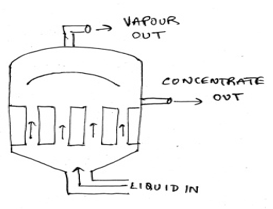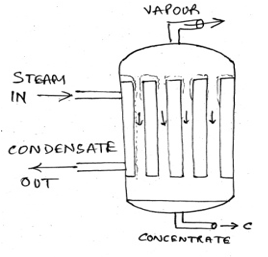This set of Heat Transfer Operations Multiple Choice Questions & Answers (MCQs) focuses on “Types of Evaporators”.
1. Which one of the following is not a type of evaporator?
a) Forced Circulation
b) Natural Circulation
c) Nucleate Boiling
d) Gasketed evaporators
View Answer
Explanation: Evaporators can be classified on numerous parameters, such as the circulation type- Natural or Forced, Boiling type- Nucleate and Non-Nucleate, etc. Gasketed Evaporators is not a class of evaporators.
2. Refrigerators use liquid coolants which evaporate in an evaporator installed in a closed chamber.
a) True
b) False
View Answer
Explanation: In an air-conditioning system or a refrigeration system, cooling occurs by passing a compressed coolant, for example R-22 (Freon) or R-410A, to evaporate/vaporize to gas inside the setup/refrigerator while taking in heat from the surrounding target area, for example a refrigerator cage or rooms, in the process.
3. Which one of the following is not a suitable application of evaporators?
a) Refrigeration
b) Cooling
c) Heating
d) Crystallisation
View Answer
Explanation: Heating is not a possible application of evaporators, whereas it is usually used for concentrating solutions as a feed to crystallization, re-evaporation of compressed liquids, refrigeration applications, and generation of vapours for process applications.
4. What is the driving force for evaporation to take place?
a) Difference in partial pressure
b) Difference in pressure
c) Difference in Concentration
d) Difference in temperature
View Answer
Explanation: The driving force for evaporation to take place is the partial pressure difference of the vapour from the evaporating surface and the surrounding that promotes mass transfer to take place. It is not concentration/pressure differences as they hold for liquid and bulk respectively.
5. Crystallizers are one of the most important setups in industries nowadays. It is solely used to dry a solution to an extent to obtain the crystals of the solute. Which one of the following is the most suitable operation to carry out this process?
a) Forced Circulation
b) Natural Circulation
c) Nucleate Boiling
d) Non-nucleate Boiling
View Answer
Explanation: Forced circulation is observed when boiling is suppressed at the heating surface due to the hydrostatic heads operating on it, hence falling film evaporators which generally use crystallizers, viscous fluids, waste streams, and other fouling fluids, nucleate boiling would naturally increase their fouling rate and is hence is not suited.
6. Why don’t we use Natural convection for evaporating waste streams, crystallizers, and viscous fluids?
a) Slow process
b) Sedimentation problem
c) Prevents fouling at the heating surface
d) Causes overheating
View Answer
Explanation: Forced circulation is observed when boiling is suppressed at the heating surface due to the hydrostatic heads operating on it, hence falling film evaporators which generally use crystallizers, viscous fluids, waste streams, and other fouling fluids, nucleate boiling would naturally increase their fouling rate and is hence is not suited.
7. Falling film evaporators are those in which evaporation takes place from the film interface with nucleate boiling at the wall.
a) True
b) False
View Answer
Explanation: Falling film evaporators are those in which evaporation takes place from the film interface with no nucleate boiling at the wall because of the extensive fouling that is created by it.
8. How are the tube surfaces in falling film evaporators heated to enhance evaporation?
a) Heaters at about 200℃
b) Heaters at above 200℃
c) Heaters at just above 100℃
d) Steam condensing at the outer wall
View Answer
Explanation: Falling film evaporators are those in which evaporation takes place from the film interface with no nucleate boiling at the wall because of the extensive fouling that is created by it. Hence to avoid nucleate boiling, we usually use steam as the heating agent.
9. Which one of the following is not a subset of Nucleate boiling evaporators?
a) Climbing Film Evaporator
b) Rising Film Evaporator
c) Short-tube Vertical Evaporator
d) Falling Film Evaporator
View Answer
Explanation: Falling film evaporators are those in which evaporation takes place from the film interface with no nucleate boiling at the wall because of the extensive fouling that is created by it. Hence to avoid nucleate boiling, we usually use steam as the heating agent.
10. Recognize the following evaporator.

a) Falling Film Evaporator
b) Short-tube Vertical Evaporator
c) Climbing Film Evaporator
d) Basket-type Evaporator
View Answer
Explanation: The direction of flow of fluid in the tubes clearly indicates the that the fluid is rising up, hence it is known as rising film/ climbing film evaporator.
11. Recognize the following evaporator.

a) Falling Film Evaporator
b) Short-tube Vertical Evaporator
c) Climbing Film Evaporator
d) Basket-type Evaporator
View Answer
Explanation: The flow direction is downward and the heating is done by a gas that has temperature high enough to cause nucleate boiling. As the tubes are short and there is a basket, it is known as a short tube vertical evaporator.
12. Recognize the following evaporator.

a) Falling Film Evaporator
b) Short-tube Vertical Evaporator
c) Climbing Film Evaporator
d) Basket-type Evaporator
View Answer
Explanation: The flow direction is downward and the heating is done by a gas that has temperature not high enough to cause nucleate boiling. As the tubes are short and there is a basket, it is known as a Falling Film evaporator.
Sanfoundry Global Education & Learning Series – Heat Transfer Operations.
To practice all areas of Heat Transfer Operations, here is complete set of 1000+ Multiple Choice Questions and Answers.
If you find a mistake in question / option / answer, kindly take a screenshot and email to [email protected]
- Apply for Chemical Engineering Internship
- Check Chemical Engineering Books
- Practice Chemical Engineering MCQs
- Check Heat Transfer Operations Books
